Enhancing Student Communication and Engagement in Large First-Year Cohorts Using Padlet
Introduction
Teaching large undergraduate cohorts poses several challenges, especially when the majority of students do not have a background in the subject. In the module ECO1031 Data Analytics for Business, which comprises over 300 predominantly non-economics first-year students, communication barriers became increasingly apparent. The lecture hall setting, characterised by its size and acoustics, further exacerbated the issue. Most students were reluctant to ask questions during lectures, which posed a significant challenge for me as a lecturer. Without consistent student input, it was difficult to assess their understanding, identify misconceptions, or adapt my teaching strategies to better support their learning needs.
Following repeated post-lecture emails from students seeking clarification on topics covered in class, I recognised the need to establish a more responsive and accessible communication channel during lectures. To address this, I introduced Padlet as a digital tool to facilitate real-time interaction between myself and the students.
Rationale and Implementation
The use of Padlet was driven by three core objectives: first, to check whether students were achieving the intended learning outcomes by posing questions during the lecture; second, to provide an immediate and anonymous channel for students to ask questions in real time; and third, to foster an inclusive, low-pressure environment that encourages participation from all students, including those who might otherwise remain silent in a traditional classroom setting.
The idea was further developed after consulting with lead students from the Peer Study Group, who helped shape an action plan for the module. I launched a dedicated Padlet link for ECO1031 Data Analytics for Business and integrated it into lecture slides via a scannable QR code.
At the beginning of each lecture, I encouraged students to post their questions, whether related to the lecture content, assessment components, or any other aspect of the module, at any point during or after the session. I paused every 15 minutes to review the Padlet and respond to the questions in real time. Students really liked the new communication tool and actively used the Padlet link to ask questions.
Impact on Communication and Learning
The use of Padlet in ECO1031 demonstrated several tangible benefits. First, it significantly improved the efficiency of communication between myself and the students. Rather than waiting until the end of the lecture or relying on email, students could ask questions in real time and receive timely responses from me.
Second, Padlet helped overcome barriers typically associated with large-group teaching, particularly among first-year home and international students, who, in my experience, are often more hesitant to ask questions during lectures. By providing anonymity, Padlet created an environment where students could actively participate in class by answering my questions and asking their own without hesitation or concern.
The tool also served as a formative assessment aid. I used Padlet not only to answer questions but also to pose my own—checking student understanding mid-lecture and adapting my teaching accordingly. This feedback loop made the lecture more interactive and responsive.
Evidence of Student Engagement through Padlet
Out of 320 students enrolled in the module, 176 individual student users engaged with the Padlet board, representing 55% of the entire cohort. Between January and May 2025, these students submitted a total of 270 posts, with each user defined as having posted or commented at least once during the term. This indicates that over half the students actively interacted with the platform.
The platform received 1,290 views from 545 students, with a total cumulative engagement time exceeding 33 hours. Over the course of 11 teaching weeks, the Padlet board received a total of 270 posts, averaging approximately 25 posts per week, which highlights the consistent level of student interaction and ongoing engagement throughout the term.
These figures demonstrate both widespread adoption and meaningful engagement. The high rate of in-room participation suggests that the Padlet board effectively bridged the communication gap commonly experienced in large lecture settings and empowered students to contribute more actively during lectures.
These figures indicate consistent interaction with the platform across the term. Notably, nearly 92% of students attending lectures engaged with the Padlet board (176 out of 192), suggesting the tool effectively encouraged participation from a broad range of learners, including those who might be reluctant to speak in a traditional lecture format. Posts ranged from clarification questions and technical issues to assessment queries and peer discussions. While the primary goal was to create a direct communication channel between students and lecturer, the board also enabled spontaneous peer-to-peer responses. I encouraged students to actively engage with their peers after noticing that some were highly motivated to respond to questions posted by their classmates on Padlet.
Fostering Student Engagement
Based on the survey results from 49 student responses, the use of Padlet’s anonymous question feature was well received. A combined 76% of respondents (24 agreed, 13 strongly agreed) reported feeling comfortable asking questions anonymously through Padlet.
Figure 1: "I felt comfortable asking questions anonymously or through Padlet."
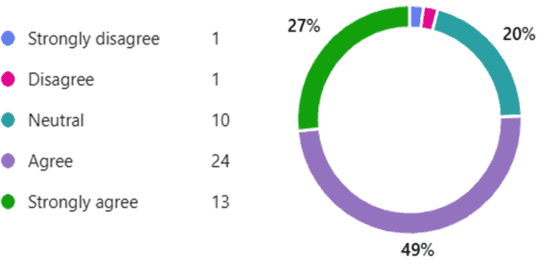
Moreover, it demonstrates that the use of Padlet significantly contributes to the principles of Equality, Diversity, and Inclusion (EDI) by creating a more accessible learning environment for all students.
Based on responses from 50 students, the frequency of Padlet use varied across the cohort. Nearly half of the students reported interacting with Padlet 1 to 3 times, while 30% engaged with it 4 to 6 times. 8% of the students used the platform seven times or more, and only 14% reported not using Padlet at all. These findings indicate a strong level of engagement, with 86% of respondents participating at least once during the module.
Figure 2: How many times did you post or interact on Padlet in this module?
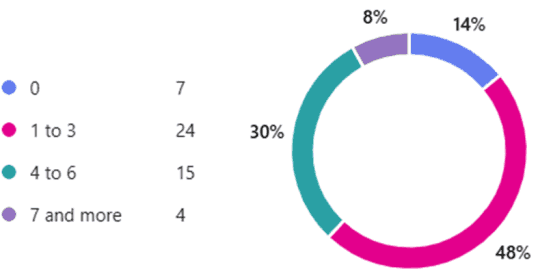
Moreover, the use of Padlet during lectures had a positive impact on student engagement. 53% agreed and 14% strongly agreed that Padlet made them feel more engaged. These results indicate that the integration of Padlet contributed to enhanced student focus and interaction during the lecture.
Figure 3: "Using Padlet made me more engaged during the lecture."
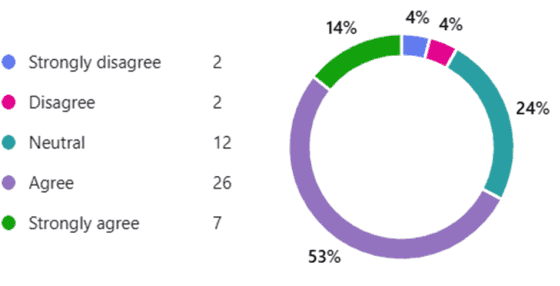
Furthermore, Padlet significantly supported students in asking questions during lectures. 45% (22 students) agreed and 27% (13 students) strongly agreed that Padlet improved their ability to ask questions.
Figure 4: "Padlet improved my ability to ask questions during lectures."
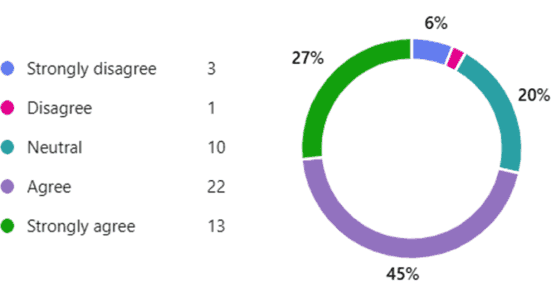
Evidence of Effectiveness
In Term B of the 2024–25 academic year, I received 270 posts from students on Padlet. Based on feedback from 49 students, receiving timely replies from the lecturer via Padlet had a strong positive impact on learning. 49% agreed and 27% strongly agreed that the timely responses helped them better understand the material.
Figure 5: "Receiving timely replies from the lecturer through Padlet during the lecture helped my learning."
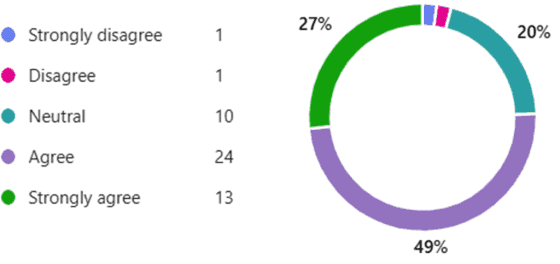
One of the most valuable features of Padlet is its ability to support 24/7 access, allowing students to ask questions at any time during and outside of scheduled lectures. This flexibility enabled students to seek clarification about topics in the module or upcoming assessments whenever needed. Based on responses from 48 students, 33% agreed and 19% strongly agreed that using Padlet inside and outside lectures made them feel more connected to the lecturer and supported in their learning.
Figure 6: "Using Padlet inside and outside of lectures helped me feel more connected to the lecturer and supported in my learning."
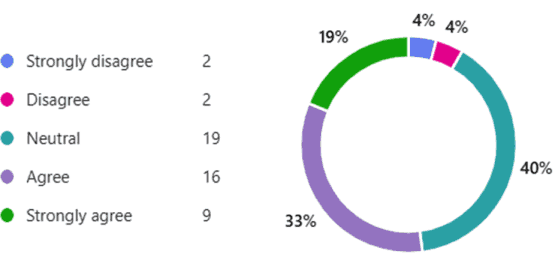
Unexpectedly, Padlet also facilitated peer-to-peer interaction. Some students began replying to their peers’ questions, creating a collaborative learning environment beyond what I had initially anticipated. This peer engagement helped cultivate a more supportive atmosphere in this module.
Based on responses from 48 students, the majority found that viewing their peers' questions and answers on Padlet enhanced their learning. Specifically, 46% agreed and 23% strongly agreed that it helped them learn better.
Figure 7: "Seeing peers' questions and answers helped me learn better."
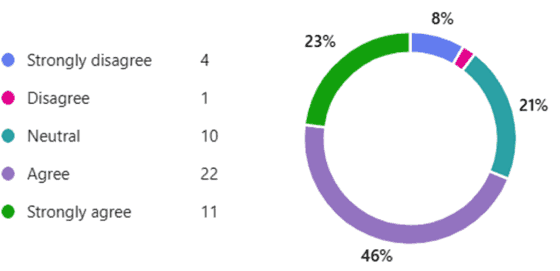
Additionally, there was strong support for expanding the use of Padlet across other modules; for example, 45% of students agreed and 37% strongly agreed that they would like to see Padlet used more widely.
Figure 8: "I would like to see Padlet used in other modules, especially in larger ones."
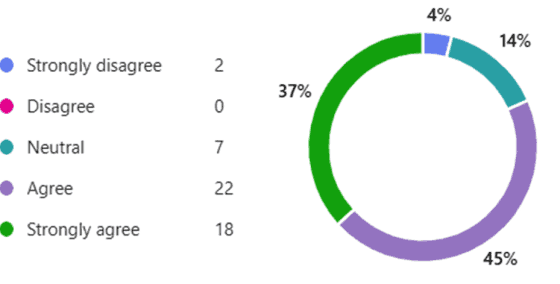
Challenges in Moderating Padlet Contribution
One of the challenges encountered during the use of Padlet was that some students occasionally posted irrelevant or non-academic content. These off-topic posts disrupted the learning environment by diverting attention from the subject matter for both myself as the lecturer and the students attending the session. To address this, I kindly reminded students to use Padlet only for academic purposes and promptly removed any inappropriate messages.
Conclusion
The integration of Padlet into ECO1031 lectures has proven to be a highly effective intervention for addressing the communication challenges inherent in large, first-year, non-specialist cohorts. It has enhanced both student engagement and learning by creating a safe, accessible space for dialogue and feedback. Beyond facilitating interaction with the lecturer, Padlet has also encouraged peer-to-peer support, contributing to a more cohesive learning community.
Its flexibility, ease of use, and ability to promote inclusive learning make Padlet a valuable tool for delivering classes to large cohorts. Given the overwhelmingly positive response from students, I plan to continue using Padlet in future modules and advocate for its broader implementation across the curriculum.
↑ Top
